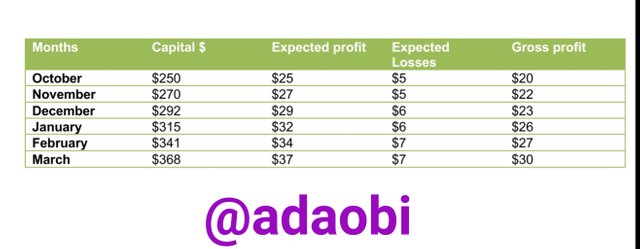Capital Management and Trading Plan - Crypto Academy / S4W8 - Homework post for @ lenonmc21
 cover made from photogrid
cover made from photogrid
Introduction
In our daily activities, we do plan on what we want to achieve for that day. Sometimes, the days we don't plan,we end up wasting the whole day. In the same vein, trading requires planning. This is because a little mistake can swallow up your capital. So there must be a rule to follow. There must be a trading guide. This is why it is crucial to study this subject of trading plan to gain full knowledge of what it is.
1. Define and Explain in detail in your own words, what is a "Trading Plan"?
In our daily affairs, we normally do plan how our day will be like. Sometimes we put the things we wish to achieve down in a book and call it our to-do list. That list will serve as a reminder on the things we want to achieve that day. Most times, if we do not plan ahead, we end up deviating from the main tasks for the day. Also, in the ten principles of personal finance, rule number two states that Nothing Happens Without a Plan.
 Image made from photogrid
Image made from photogrid
In the cryptocurrency trading profession, it is quite difficult to tell what will happen in the next minute. the cryptocurrency market is very volatile and there is a tendency of making huge losses if precautions are not taken. Before taking any action, one has to guard against the worst event that could happen in the next minute.
In order not to lose all our capital, we have to give ourselves limit to whatever action we want to take. We can do this by mapping out some guidelines that we will follow to minimise losses and maximize profits. This is known as A trading plan.
A trading plan is a set of rules prepared by a trader, who follows these rules vividly to avoid losses. In developing this plan, a trader takes into consideration his capital, the profit he wants to make, the maximum percentage of losses he can bear as well as the time frame for the trading activity.
One thing this trading plan does is that it places a limit to whatever action we take, whether buy or sell.
A trading plan also stops a trader from trading greedily. Take for instance, if I want to sell an asset and make a certain profit according to my trading plan, once the price of that asset is in a position I can make that profit, I will sell the asset no matter how promising the price may look. A trading plan serves as a direction to traders.
Traders must have control over their capital because if we lose our capital, all our previous efforts would be in vain. How can we exercise this control? It is by setting some rules that will keep us on a safe side.
Trading plan cannot be altered no matter how unpleasant it may look, except if the plan is no longer valid. It must state clearly the entry and exit rules as well as the conditions of the market that will trigger a buy or sell move. It must contain some written down objectives. In a nutshell, a trading plan is a roadmap that traders must follow in order not to be lost in the fuzz.
2. Explain in your own words why it is essential in this profession to have a "Trading Plan"?
Trading especially in the cryptocurrency space is not something that should be done without a plan. Due to the volatility of the market, it is important that we plan. Remember, if we fail to plan, we are planning to fail. There are many reasons why planning is important in the trading profession. They are discussed below.
- Planning reduces losses: To some extent, setting a trading plan and following it vividly protects us from some misconducts that might bring losses.
- It makes us focus on the goal: A trading plan will make a trader to strife as much to meet the objectives that was stated in the plan.
- It help traders avoid some costly and delicate mistakes that can push them to the bar.
- It serves as a control mechanism: A trading plan will not only help us reach our goals and minimize losses, it also help us to compare our actual performance with the expected performance. This will help us take some corrections ahead of next time.
- Confidence: Trading plan also help us trade with confidence. Because the risk and capital are properly managed, there is less to be worried about.
- Finally, it helps us not to expose ourselves so much to the market.
3. Explain and define in detail each of the fundamental elements of a "Trading Plan"
In order to draw a valid trading plan that will help a trader manage his or her capital well, there are some fundamental elements that must be considered. These are the basic capital management plan. They are discussed below;
1. Time management:
2. Risk Management:
There are two possible outcome for every trading activity. It's either we make profit or we bear some losses. In order to reduce or minimise losses, we have to set a limit for our actions. With Risk management, a trader can choose the number of entries to make as well as the maximum number of trades he can win or lose to quit the market. Let me break this down with an example..
Supposing my plan is to make a profit of $20 in a day, and what I can lose is $5. Once I hit the target of $20, I have to quit the market for that day, because I might end up losing more money if I want to continue. In the same way, if I'm not so fortunate that I lose $5 maybe at my first entry, I also have to adhere to what is in my trading plan and exit the market for that day in order not to lose more. This is how to manage risk.
Risk management seeks to minimize losses and maximize profits. Once we have this component in our trading plan and follow suit, we will have more returns on all trading and investment activities.
3. Capital Management:
This is a control mechanism that allow traders to define a portion of their capital that they are willing to risk. Capital management has to do with deciding the percentage of our total capital that we can afford to lose. Remember, every trading activity has a percentage of risk. So the moment we enter the market, we are taking a risk with our money. There is only a certain percentage of our capital that we can afford to lose. Capital management allow us to clearly define that amount we would risk for each trading operation.
Capital management has two important features; the profit percentageand the loss percentage. The profit percentage can be that we want to make a profit of 5% of our total capital. Once we achieve this, we withdraw from the market to save ourselves from capital losses. The loss percentage on the other hand is the portion of our capital that we are willing to let go. If our loss percentage is 2% of our total capital, we should stick to the plan and not deviate. Also, we can't trade everyday. Choosing the number of days we would be trading will also help in managing our capital.
4. Trading Psychology:
This has to do with following the rules of the game in order not to lose more money. On a norm, it is typical of we human to fight for more money. Sometimes, if we win a trade, we will want to still enter to win more, thereby deviating from what is in our trading plan. We have to stick to our risk management plan and capital management.
In addition to the risk and capital management, it is wise to set additional rules for ourselves. Most importantly, it is not healthy to trade with our emotions as this will expose us incurring more losses.
Also in trading Psychology, we have to follow our minds. If our mind tells us not to enter the market, it is better to refrain from it. Likewise, if we are very optimistic about a trading position, it is most likely that we will win. Devote time to monitor your trading activities.
Do not let anything distract you when you are doing something this important. Know that anything can happen. The worst can even happen where you get to lose almost everything. Once you guard your mind with this knowledge, you will operate to your best interest.
It is not everytime that you will have to trade. Sometimes you should give yourself a break and try to make something positive out of that moment.
5. Profit Expected:
This was discussed previously when we were talking about risk management and capital management. The expected profit should be precise and boldly stated. Once we meet this target, it would be best to leave. Also, we should not put in huge capital and expect a minimal profit. We should risk our capital for something better. The percentage of the capital that we want to recover as profit should be concise.
4. Build a “Trading Plan” and cover all the basic elements discussed in the class. For this, you should NOT take the examples that I put in my class (Including the example amounts), use your own examples and own images to make said plan, you must also base this "Trading Plan" as if you were operating on the platform of " Binance ”, taking into account that the minimum amount of exchange or investment is $ 10.
 table made in MsWord
table made in MsWord
The first column shows the number of months the trading plan covers. As shown, the plan covers a six months period; October to March. The second column is for capital. The opening capital is $250 and the profits made in each month is added to the capital of the next month.
The third column shows the expected profit which is approximately 10% of the capital. The fourth Column is the maximum amount of losses that can be incurred. This also is an appropriate value of 2% of the capital. The final column is the gross profit that is expected, without any trading expenses.
Capital management:
Risk management:
My personal trading Psychology:
- No Greed: Being greedy is totally out of it. I have been a victim of this. Hence, I have taken it as a norm to always exit once my target has been made.
- I don't enter a trade to take revenge. No matter the previous experience, I will still trade to make profit and not to cover up the past. Taking revenge on the market can cause more damage than we could ever imagine.
- I follow my instincts. If I feel insecure about a trade, I will refrain from it. Going against my mind has always resulted in a loss.
- I don't jump into a trade because my friends have made so much from it. It may not end well.
Conclusion
Trading plan is an important aspect of cryptocurrency trading. Sometimes we just enter and exit the market whenever we feel like without any capital or risk management measures. We trade without really considering what the outcome will be. In this class, we have learnt that it is important to have a plan that will serve as a roadmap for our trading activities. It was nice learning about Capital Management and Trading Plan. Thank you professor @lenonmc21 for this opportunity.